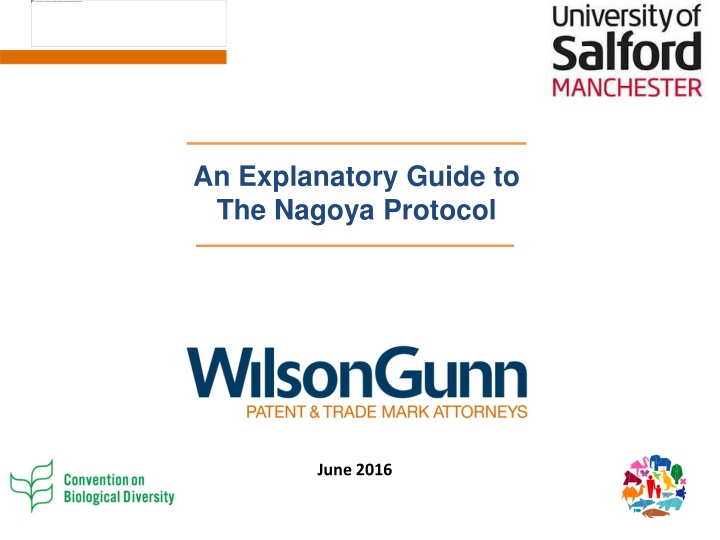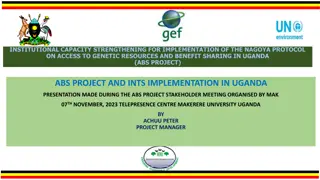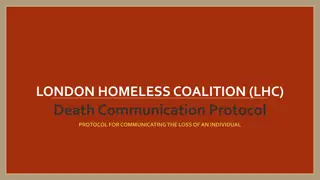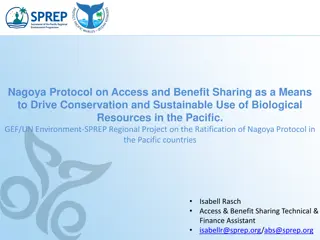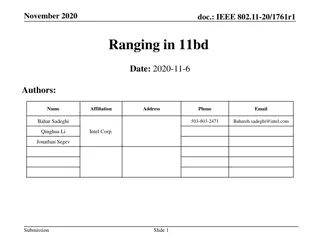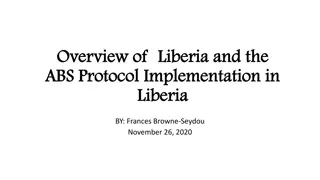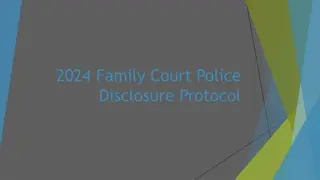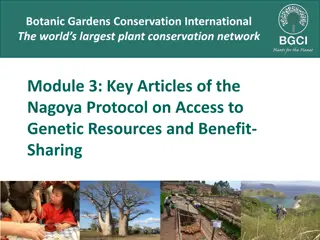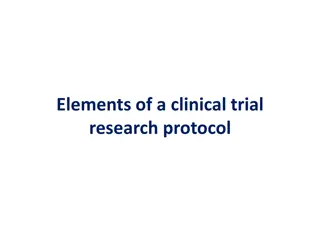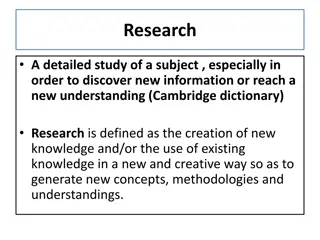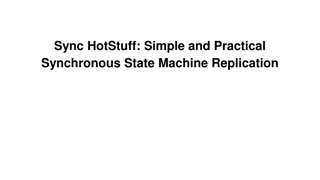An Explanatory Guide to The Nagoya Protocol
A comprehensive overview of the Nagoya Protocol, a supplementary agreement to the Convention on Biological Diversity aimed at fair benefit sharing and preventing bio-piracy. It covers key points, access and benefit sharing, due diligence, impact on patents, and more. The protocol governs utilization of genetic resources and traditional knowledge related to genetic resources, placing responsibility on researchers to obtain legal access and share benefits equitably. Not complying with the protocol can render research illegal.
Download Presentation

Please find below an Image/Link to download the presentation.
The content on the website is provided AS IS for your information and personal use only. It may not be sold, licensed, or shared on other websites without obtaining consent from the author.If you encounter any issues during the download, it is possible that the publisher has removed the file from their server.
You are allowed to download the files provided on this website for personal or commercial use, subject to the condition that they are used lawfully. All files are the property of their respective owners.
The content on the website is provided AS IS for your information and personal use only. It may not be sold, licensed, or shared on other websites without obtaining consent from the author.
E N D
Presentation Transcript
An Explanatory Guide to The Nagoya Protocol June 2016
An Introduction to the Nagoya Protocol Key Points of the Protocol Nagoya in the UK Access and Benefits Sharing Clearing House (ABS-CH) IRCC Seek, keep and transfer procedure Due Diligence The effect of the Nagoya Protocol on patents Actions for the University of Salford
An Introduction to the Nagoya Protocol 12 October 2014 The Nagoya Protocol enters into force in the EU (EU Reg. 511/2014) 09 November 2015 Rules regarding the registration of the collection of genetic resources, monitoring user compliance and best practices enters into force (EU Reg. 2015/1866) The Nagoya Protocol is a supplementary agreement to the Convention on Biological Diversity (CBD). Aim of the Protocol: To provide a legal framework for the implementation of one of the three objectives of the CBD: the fair and equitable sharing of benefits arising out of the utilization of genetic resources, thereby contributing to the conservation and sustainable use of biodiversity. Prevention of bio-piracy The commercial or academic development of genetic resources by a country or organisation without obtaining prior consent from, or providing fair compensation tom the people or country where the resource was first discovered.
The Nagoya Protocol relates to the utilisation of genetic resources and traditional knowledge associated with genetic resources. A genetic resource is defined as any non-human genetic resource. Utilisation refers to research and development on the genetic and/or biochemical composition of genetic resources. The Protocol, therefore, relates to both commercial and academic research. The Nagoya Protocol gives provider countries the rights to control access to genetic resources found within their jurisdiction. Two categories of provider country: 1. An originating country where the genetic resource exists in situ, i.e. genetic resource exists in its natural habitat. 2. An originating country where the genetic resource exists ex situ, i.e. genetic resource exists outside of its natural habitat. A country falling within this category must have obtained the genetic resource from an originating country under the CBD.
The burden is placed on the user (researcher) to show that the genetic resource on which research is being conducted was legally obtained in accordance with the Nagoya Protocol. In order to do this, a user must: 1. Obtain the prior informed consent (PIC) of a providing country (i.e. the country where the genetic resource exists in situ) before access to a genetic resource is permitted 2. Provide a fair and equitable share of the benefits which arise from utilisation of the genetic resources. Such sharing shall be upon mutually agreed terms (MATs). The benefits can be either commercial (e.g. monetary) or non-commercial, including the sharing of data or a transfer of intellectual property rights. The effect of the Nagoya Protocol is to make it illegal to perform research and development on a genetic resource that has not been accessed in accordance with the Nagoya Protocol. For the Nagoya Protocol to apply, the genetic resources must be accessed by an EU member state after entry into force of the Nagoya Protocol for the EU, i.e. on or after 12 October 2014.
All states party to the Protocol must appoint a Competent National Authority (CNA). - An executive agency for ensuring fair and accurate measurements are available and used for transactions - Responsible for enforcing the Nagoya Protocol, including; monitoring compliance, inspecting due diligence and raising awareness of the Nagoya Protocol. The National Measurement and Regulation Office (NMRO) appointed as the Competent Authority in the UK. Department for Environment, Food and Rural Affairs (DEFRA) will be the National Focal Point in the UK. - A resource for answering questions, explaining information regarding the Protocol etc. Penalties for non-compliance Made at the discretion of each EU member state different consequences in different member states In the UK DEFRA have indicated a fine up to 250,000 and a maximum of two years in prison for severe cases of wilful non-compliance
ABS-CH is an international body which provides a platform for exchanging information concerning a provider country s legislative measures, details of CNAs etc., and is a key tool for facilitating the implementation of the Nagoya Protocol. Each provider country informs the ABS-CH of its national provisions with regards to access and benefits sharing (ABS) information. The role of the ABS-CH is to provide: a database comprising the access and benefit sharing requirements of each provider country including the provider country s national provisions and legislation, contact details of the CNA within the provider country, and internally recognised certificates of compliance (IRCC) the legislative and practical information required by a user to access a genetic resource and associated traditional knowledge from a provider country in accordance with the Nagoya Protocol A platform between a provider country and a user to discuss mutual terms upon which access to a genetic resource and traditional information can be shared. An internationally recognised certificate of compliance (IRCC) evidence that the genetic resource has been accessed in accordance with the Nagoya Protocol.
PIC/MAT negotiated between user and Competent National Authority within the provider country using the ABS-CH as an internet-based platform Competent National Authority issues a national permit to ABS-CH ABS-CH issue IRCC to the user as evidence of compliance with the Protocol
A user is required to seek, keep and transfer the IRCC (or other relevant documents) to subsequent users of the genetic resource as evidence that the genetic resource has been accessed in accordance with the Nagoya Protocol. Any information not contained within the IRCC which relates to the MATs must also be part of the seek, keep and transfer procedure. The IRCC also needs to be provided to the ABS-CH when certain trigger events occur. MATs can be renegotiated if original MATs were only for non-commercial use of a genetic resource. Trigger event, e.g. commercialisation of product User must present IRCC to ABS-CH ABS-CH forward IRCC and details of trigger event to CNA CNA can renegotiate MATs with user
Users (e.g. researchers) are required to exercise due diligence to establish that genetic resources have been accessed in accordance with ABS requirements. Exercising due diligence will show: Prior informed consent (PIC) of a provider country before access to a genetic resource is permitted Mutually agreed terms (MATs) have been established A fair and equitable sharing of the benefits arising from utilisation of a genetic resource (and the associated traditional knowledge) has been established with the provider country All recipients of research funding which involves the utilisation of genetic resources and traditional knowledge will be requested by EU Member States to declare due diligence was exercised in accordance with the Nagoya Protocol. All information relating to access and benefits sharing must be kept by the user for 20 years after the end of the period of utilisation.
Supporting due diligence Two EU provisions to assist Users: 1. Registered Collections (EU Reg 511/2014, Art. 5) low burden on the user Internet-based register established by the European Commission (EC) comprising sets of collected samples of genetic resources that is accumulated and stored. A user obtaining a sample from this register shall be deemed to have exercised due diligence in accordance with EU regulations. 2. Best Practice Recognition (EU Reg 511/2014, Art. 8) greater burden on the user Associations of users may submit an application to the EC to have a combination of procedures, tools or mechanisms, developed by them, recognised as a best practice in accordance with the Protocol. The application must be supported by evidence and information. If an inspection of a user s procedure shows that it complies with due diligence obligations, a lower frequency of future inspections may result still a significant burden on the user. A register of recognised best practices will be established by the EC.
Difficult to predict Currently, there are no plans to amend the European Patent Convention (EPC) in response to the Nagoya Protocol. However, the implementation of a proposed policy from the World Intellectual Property Organisation (WIPO) (WIPO/GRTKF/IC/28/4; Art. 3) would require a patent application to disclose: the origin of genetic resources and/or traditional knowledge, ABS requirements imposed by the relevant CNA (including PIC), and if the origin of the genetic resource is unknown, a declaration to that effect. This may result in the prevention of grant of a patent through lack of sufficiency of disclosure, rather than an explicit lack of compliance with the Nagoya Protocol. This would allow the European Patent Office to ensure patent applicants abide with the provisions of the Nagoya Protocol without the need to amend the EPC.
Researcher receives funding for research Genetic resource (or its 1. Initial planning stage derivative) identified by researcher NMRO (as CNA) Researcher registers provide on ABS-CH website guidance on PIC (preferred method) and MATs
A 2. Is the Nagoya Protocol applicable to the required genetic resource B A If the genetic resource is obtained from a registered collection established in accordance with EU Reg Art. 5, requirements relating to due diligence are fulfilled. C B Significant countries not party to Nagoya are United States of America, China and Canada. C Some countries are proposing to implement legal frameworks encompassing the ABS provisions of Nagoya. It is thought these frameworks will be accepted as an alternative to ABS.
A 3. Due Diligence A Parties may implement international agreements which remove the need to obtain PIC (provided the agreements do not run counter to the objectives of the Protocol). B B An IRCC comprising information on PIC and MATs can be used as evidence that the genetic resource has been accessed in accordance with the Protocol. This information can be used as part of the seek, keep and transfer procedure and must be kept for 20 years after the end of utilisation of the genetic resource. C C If an IRCC is not yet available, the researcher must seek, keep and transfer other relevant documents related to the genetic resource.
Practical actions to be taken 1. Due diligence paperwork Ensure existing genetic resources are sufficiently documented as having been accessed before the date of entry into force of the Nagoya Protocol in the EU (i.e. before 14 October 2014). The Nagoya Protocol will not have retroactive effect in the EU. Hence, genetic resources shown to be accessed before the Nagoya Protocol will not be required to comply with the EU regulations which set out the Protocol in the EU. 2. Administrative preparations Take action to ensure administrative systems are in place to make certain any new genetic resources are documented in compliance with the Nagoya Protocol: Date and place of access Description of genetic resource utilised Direct source of genetic resource/traditional knowledge, any subsequent users ABS agreements, access permits, MATs, any rights or obligations related to ABS. 3. Internal procedures Carry out internal training to make employees aware of the Nagoya Protocol and the obligations of users of any genetic resources. Ensure employees understand that legal possession of a genetic resource does not necessarily imply that person has the right to do any work on or with that resource. 4. Origins Be aware of the origin of any genetic resources you might wish to use for the purposes of research and development.
Thank you UK leading firm 2015 (The Legal 500) Ranked by Chambers and Partners (2016) www.wilsongunn.com Manchester Office: Birmingham Office: Liverpool Office: Chesterfield Office: London Office: 0161 827 9400 0121 236 1038 0151 242 6703 01246 541 903 0203 178 2767
